看见良渚玉,看见千年
2019-07-26
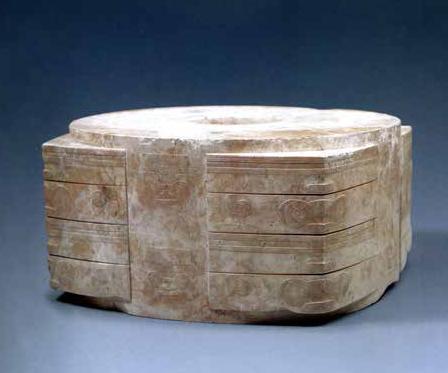
玉琮王
良渚古城,是良渚王国权力与信仰的中心,而玉器作为权力与信仰的载体,在良渚王国中占据极其特殊的地位。
玉文化与治玉精神传承至今。而玉象征的含义,也为良渚新时代的文化发展注入新的内涵。
良渚好玉
良渚古城遗址的出土器物包括玉器、陶器、石器、漆器、竹木器、骨角器等,總量达1万余件。其中,玉器主要作为随葬品出土于分等级墓地,总数不少于7000件,材质以透闪石为主,器型包括玉琮、玉钺、玉璧、三叉形器、冠状饰、锥形器、玉璜、半圆形饰、柱形器、玉镯、玉织具、玉纺轮等,以及圆雕的鸟、龟、鱼、蝉等动物形玉器。
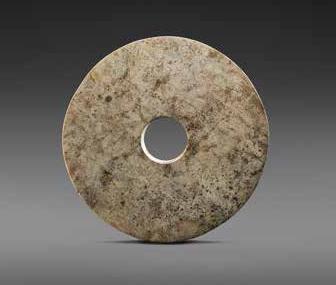
“鸟立高台纹玉璧”。
7月16日,一个集全国各地良渚玉器之大成的展览在北京故宫博物院举行, 将持续至10月20日。这个名为“良渚与古代中国——玉器显示的五千年文明”的特展,是良渚文化展览史上,以玉器为主的良渚文化的集大成展,也是目前良渚玉器规模最大的展览。
展览调动了反山12号墓出土的国王用玉以及瑶山11号墓出土的王后用玉,总共119件玉器,包括玉琮王、玉钺王、良渚文化刻鸟立高台符玉璧等。
像这样成组成单元地展出良渚社会中最高统治者的玉器,在良渚文化展览史上还是第一次——
琮,首创于良渚文化,为高等级贵族所有,是沟通天地人神的重要礼器。玉琮内圆外方,中部贯穿,四角施刻神人兽面像,蕴含着良渚先民的宇宙观念和精神信仰。
出土于反山12号墓的玉琮,是国王用玉。它是迄今雕琢最精美、品质最佳、体量最大的玉琮,被誉为“玉琮王”。
玉钺是从斧演变而来的一种器形,装上握杖,相当于权杖,是良渚文明中军权的象征。“玉钺王”同样出土于反山12号墓,是目前唯一雕琢有神徽和鸟纹的玉钺。
璧是一种中央穿孔的扁平状圆形玉器,体现了贵族对财富的占有。在出土的众多良渚玉璧中,绝大多数为素面无纹,极少数刻有纹饰或符号。鸟立高台纹玉璧正面雕有精细的“鸟立高台”纹饰,制作精良,是良渚玉器中罕见的珍品。
反山12号墓出土,遍布镶嵌的小玉粒,腹部一周有140多颗,长度居然能小到1-2毫米,说明当时玉材的珍贵,良渚人能充分利用边角玉料。
这是在良渚瑶山遗址7号墓墓主人头部发现的一件三叉形器。出土时上方有一件长玉管,推测良渚人使用时是把玉管插在三叉形器上佩戴的。良渚人把雕刻有神像的三叉形器戴在头上,成为神的扮演者。
玉鸟是一种玉缀件,背面有缝缀孔,出土量很少,一些还雕琢神像的眼睛,是人神沟通中重要的精灵。这件出土于反山遗址的玉鸟,长4.36厘米、两翼宽5.33厘米、厚0.93厘米,一般与玉管、玉珠等组成组佩件,作为项饰、手腕饰品或脚饰等佩戴。
玉的文化
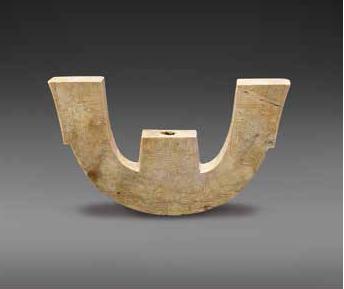
三叉形器。
良渚先民拥有高超的制玉技艺,打样、钻孔、切割、浮雕、阴刻,样样精细,鬼斧神工。比如1毫米的宽度内竟可以刻划5根线,而且互不重叠,堪称微雕。
玉器上所刻的神像,体现了良渚人统一的精神信仰。完整的神人兽面像出现在很多高等级玉礼器上。上部是头戴“介”字形羽冠的神人形象,下部是瞪着滚圆大眼、露出獠牙的猛兽面目。神人加神兽的复合形象,或许就是良渚部族崇拜的“神徽”。
良渚社会还将玉器用来标识身份、等级和地位。比如代表神权的玉琮,象征军事指挥权的玉钺,体现财富的玉璧等等。贵族与平民的随葬玉器,无论是数量还是质量,都相差悬殊。
最直观的,当属反山王陵。第12号墓中有大量玉石做成的琮、璧、钺、冠状器,成组的环镯、管珠、端饰……密密匝匝,堆出了一座“珠光宝气”的地下世界。墓主人生前,可能就是一位良渚王。
这样一种严格规范的用玉制度,见证了良渚社会的阶层分化。良渚的王、王室成员、贵族,通过玉礼器系统,达到对神权的控制,对王权、军权和财权的垄断,以此体现王权神授的统治理念。
统一精神信仰,区分社会阶层,维系地域管辖,玉是良渚文明模式的重要特征。日本学者中村慎一先生比较了各地出土的玉器,尤其是作为权力象征的玉琮后认为,它们绝大多数是由居住在良渚古城的玉工们制作,由良渚的贵族集团派送、馈赠给各地方的。
也就是说,良渚王控制政权中枢系统,直接控制了高档奢侈品玉器的生产和使用。把玉器赐给谁,等同于赐予了权力。用这样的形式承认或分派给各地贵族的地方区域治权,换取后者对“中央”的认同和支持,从而达到对各地方实行某种程度的辖制、控制。

嵌玉漆杯(复原)。
不仅如此,良渚玉器也为后世所承袭,纵贯整个中国古代社会。英国考古学家杰西卡·罗森教授说,“良渚文明逐渐消亡,先民搬迁的同时,将玉器带到了中国的其他地区,这是良渚给全中国带去的最珍贵的礼物。”
Liangzhu Jade Exhibition at Palace Museum in Beijing
Liangzhu and Ancient China: 5,000-Year Civilization in Jade Artifacts , an exhibition, started on July 16 at the Palace Museum in Beijing and will last till October. It is the first time that so many Liangzhu jade artifacts on display at one place.
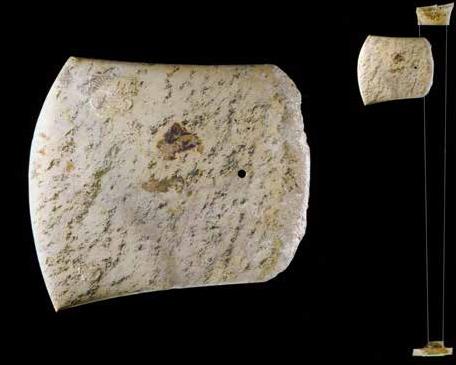
玉鉞王。
The 255 jade pieces on display, loaned from 15 museums in nine provinces and cities across the country, are all related to the Liangzhu Culture, some unearthed in ancient Liangzhu, some unearthed somewhere else in China.
The exhibition creates a comprehensive picture of Chinas earliest ritual society based on ritualized jade artifacts. It is the biggest exhibition of jade artifacts from Liangzhu in the history of China.
The 119 jade pieces from Liangzhu highlight the majesty and elegance of the king and the queen of Liangzhu, who were respectively buried in Tomb 12 at Fanshan Site and in Tomb 11 at Yaoshan Site. The 119 pieces were all unearthed from these two tombs. Never before were these particular jade pieces exhibited together at one exhibition.
The ancient Liangzhu City was a center of power and faith. Jade artifacts, vessels that carried the power and faith, played a central role in the state. The culture and spirit as reflected in these jade objects are very much alive today in China. The symbolism carried in these jade objects is injecting something new into cultural development of today.
The unearthed grave goods number more than 10,000 pieces. Over 7,000 of them are jade pieces unearthed from high-graded cemeteries. These jade objects can be classified into distinct categories such as Cong, Yue, Bi, Huang, three-pronged objects, cockscomb-shaped objects, awl-shaped objects, semi-circular pendants, cylindrical pieces, bracelets, textile tools, and small objects in the shape of birds, turtles, fish and cicadas.
King of Jade Cong
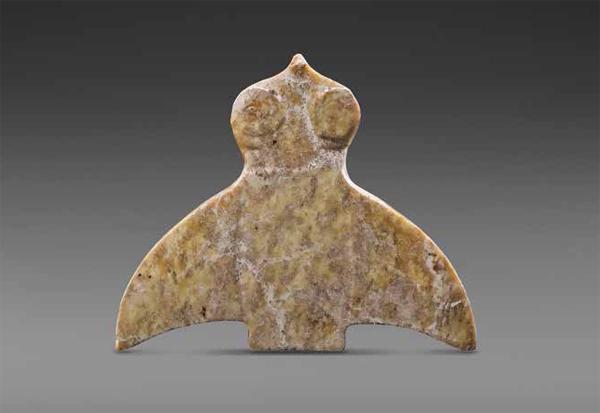
玉鸟。
Cong originated in the Liangzhu Culture. The same Cong pieces were also made in subsequent Shang and Zhou dynasties. It was a ritual object owned and used by top-class nobles for communicating with deities and nature. The Cong has a square outer section and a circular hole in the center. The four corners are ornamented with a sacred human and animal face motif. This particular Cong represents the worldview and faith of the Liangzhu people in prehistoric times. The jade Cong on display at the exhibition, excavated from Tomb 12 at the Fanshan Site, is a piece owned and used by the supreme leader of Liangzhu. It is by far the biggest and heaviest and best decorated Cong, hence the King of Jade Cong.
King of Jade Yue
Yue is a ritual object that evolved from axe. Equipped with a handle, it becomes a scepter, a symbol of military power in the Liangzhu Civilization. The King of Jade Yue was excavated from Tomb 12 at the Fanshan Site. The Yue is the only one of its kind decorated with a sacred human and animal face motif and a bird motif.
Jade Bi with a Bird on Altar Motif
Bi is a flat circular disk with a circular hole in the center, underscoring wealth in the possession of nobles. Most Bi unearthed in Liangzhu are without any decorations. Only a very small number of them are adorned with a delicately carved bird on altar motif. This Bi is an extremely rare specimen of jade artifacts of the Liangzhu Culture.
Lacquer Kettle decorated with Inlaid Jade
Excavated from Tomb 12 at the Fanshan Site, the kettle is paneled with tiny jade grains all over. Around the middle of the kettle is decorated with over 140 jade grains. These grains are as tiny as one or two millimeters in size, showing how artisans knew to recycle jade leftovers and scraps and make the biggest use of precious jade material.
Three-Pronged Jade Object
Disinterred from Tomb 7 at the Yaoshan Site, this jade artifact was placed by the head of the dead buried there. A long jade tube was found on this three-pronged jade piece. It is conjectured that the jade tube was connected with the three-pronged piece to form a unified headgear and that the wearer personated a deity.
Jade Bird
The jade bird is an ornamental jewelry composed of jade pieces stringed-together through slender strings as tiny holes are found on the backside of the bird. Some jade birds are adorned with engraved eyes of deity. This jade bird was unearthed from the Fanshan Site. It goes with a jade tube and jade beads to form a piece of jewelry for the neck or the wrist.
Jade Culture
Artisans of the Liangzhu Culture undoubtedly possessed amazingly high techniques to process jade material and manufacture jade artifacts in different shapes and ornaments. They could five lines within a width of one millimeter and the five lines dont touch each other in such a narrow space.
The image of deity carved on jade objects represents a unified faith of the Liangzhu people. Some top-graded ritual jade objects are decorated with complete images of a sacred human and animal face motif. The motif was probably the insignia worshipped by the Liangzhu people. Jade objects identified who one was and what one was in the society. For example, jade Cong represents power of faith. Jade Yue axe symbolizes military power. Jade Bi stands for material wealth. Jade artifacts exhumed from tombs of nobles and tombs of commoners show a sharp difference in both quantity and quality.
The royal cemetery at the Fanshan Site is a perfect example of the ritualized jade system. Unearthed from Tomb 12 is a large quantity of jade objects. The glittering jades suggest that the person buried there could have been a supreme ruler of Liangzhu.
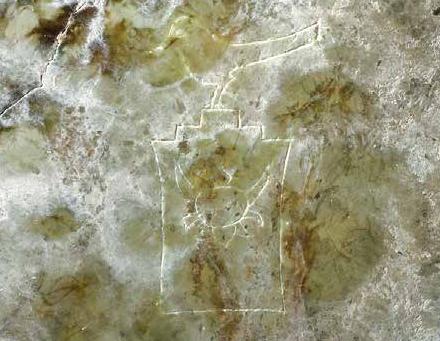
“鳥立高台纹玉璧”细节图。
This strictly ritualized jade system suggests social differentiation and hierarchy. It is through this strictly ritualized jade system that the top class of Liangzhu ruled the state and enjoyed the absolute say on religion, state power, military power and finance.
The production and use and distribution of jade artifacts were in the direct control of the supreme ruler of Liangzhu. Regional leaders received jade objects from the supreme ruler and gained recognition and power. In exchange, they supported the state government situated in the city and accepted the administrative orders from the state ruler.
Moreover, the jade artifacts of Liangzhu were inherited by other regional cultures and subsequent dynasties through the whole ancient history of China. As Liangzhu Civilization declined and dissipated, people moved to other parts of China and jade artifacts spread. Jade artifacts are the most precious gift from Liangzhu to the whole country.
